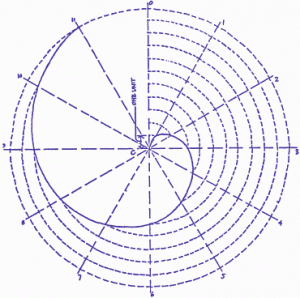 “Euclid alone has looked on Beauty bare”
“Euclid alone has looked on Beauty bare”
– Edna St. Vincent Millay
From the earliest times humanity has tried to arrange and structure it’s world and the objects within it into useful patterns and forms. The efforts of countless generations gave rise to a systematic way of achieving that objective, what we call today Practical Geometry. The accumulated experience of using Practical Geometry is a vast treasure trove which awaits users in our world today. Unfortunately, the vast array of the methods of Practical Geometry are scattered in fragments throughout time and space. There is now a way to re-unite these fragments and make available this great, powerful human resource : the Library of Practical Geometry.
What is the Library of Practical Geometry ?
The Library of Practical Geometry is a computer based information resource containing a multitude of geometric constructions with step-by-step instructions, as well as an ever-growing array of patterns, designs and motifs from a very broad spectrum of cultures and historical periods with their construction explained.
The Library is available in one convenient place, ready to use with easy to follow instructions and immediate practical application. It is arranged for multi-entry allowing specific access according to specific needs.
The Library has been developed from several hundred sources, some very rare. Obtaining the original sources of these constructions would be extremely expensive and time-consuming. The Library of Practical Geometry brings all these resources to the user at a very low price.
 Who will use the Library of Practical Geometry?
Who will use the Library of Practical Geometry?
- Anyone who uses Geometry for practical purposes (builders, architects, fabric designers, engineers, carpenters, weavers, landscape architects, graphic designers, cabinet makers, ceramicists, interior designers, embroiderers, wood carvers, stained- glass crafters, quilters, and others).
- Anyone who teaches Geometry.
- Anyone who is interested in the history of Geometry.
- Anyone who is interested in Geometry and Symbolism.
- Anyone who enjoys the sheer fun of Geometric Construction
The Origin of the Library of Practical Geometry
The Library took 3 years to initially develop nearly 35 years ago. It was based upon research into literally several hundred books, some extremely rare and obscure, in many languages. Every part of the world was reviewed and included, from earliest civilizations to the present. The techniques of thousands of Master Geometers in every field which has used and uses Practical Geometry were studied, and re-constructed. The Library was ever expanding as new sources came to light. The Library of Practical Geometry was published in handbook form for over 30 years and now is available in electronic format.
How is the Library of Practical Geometry organized?
The Library is organized into a Central Collection and Subsidiary Collections. The Central Collection of the Library includes the fundamental design concepts which are expanded on the in the The Subsidiary Collections. The Subsidiary Collections focus on a specific area of design and apply these principles to that application. The Central Collection is now available in print form refered to as the “handbook”.
The Subsidiary Collections are in development and will be released periodically over the next few months. These will only be avilable to customers who have purchased the Central Collection.
The Central Collection
The Central Collection handbook consists of three parts: of an Index, Data sheets and Bibliography.
The Index outlines the location of the data sheets in the collection by key word access. The Data Sheets contain the actual examples of Practical Geometry and are the core of the Library. These data sheets are not the entire collection, but are a assembly of the more usual constructions and designs.
The Bibliography is an abridged version of the comprehensive annotated bibliography which is the foundation of the Library.
Subsidiary Collections
The Subsidiary Collections, now in development, are dedicated to specific sub-topics within the Library which may only be presented in a few examples in the Central Collection. The Subsidiary Collections include topics such as:
- The Practical Geometry of Islam, China, India, or the Maya
- Decorative patterns of sub-Saharan Africa
- Medieval Practical Geometry
- Victorian Practical Geometry
- Embroidery patterns of Eastern Europe
- Practical Geometry of Complex Roof Forms
- Three-Dimensional Practical Geometry
- Classical and Medieval Mouldings
How is the Library of Practical Geometry updated?
The Library of Practical Geometry is periodically up-dated from the vast array of primary sources in the original resource base as well as from newly discovered sources. These updates are only available to purchasers of the Central Collection.
Visit our order page for complete details on pricing and ordering information.